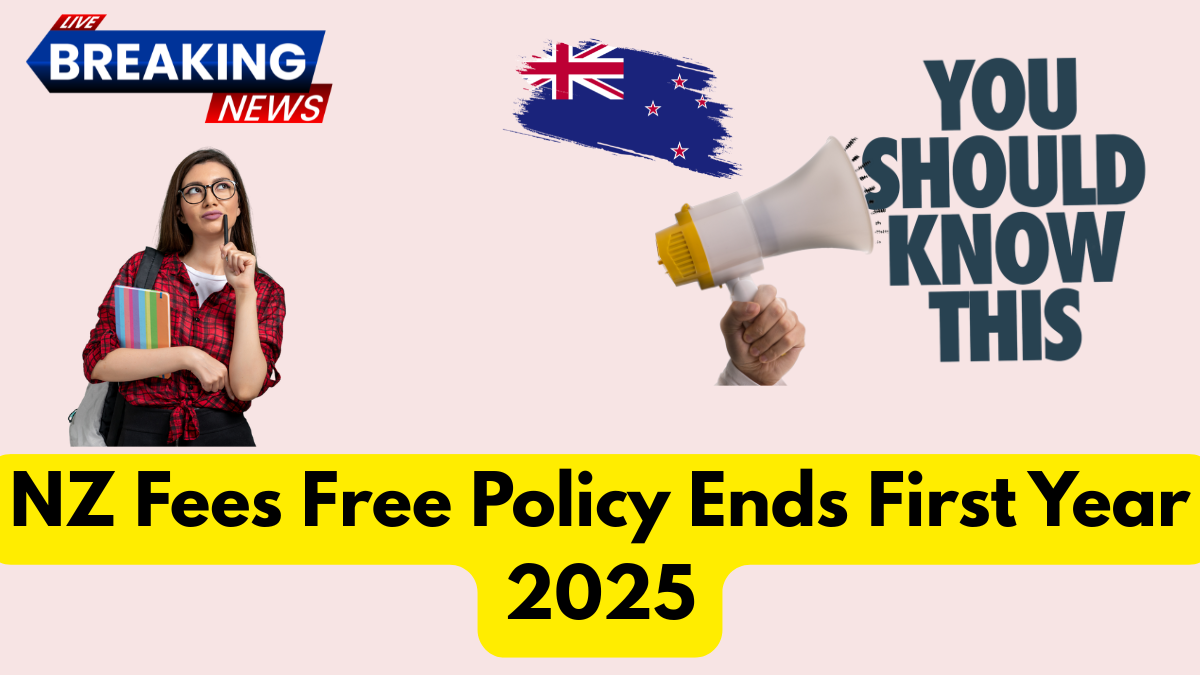Starting January 2025, New Zealand’s widely-used Fees Free policy will no longer cover the first year of tertiary education. This major shift, confirmed in the latest July 2025 tertiary funding update, marks a significant change in how post-secondary education is financed. Students planning to begin study in 2026 or later will now face up-front costs that had previously been covered under the government’s subsidy scheme.
The NZ Fees Free policy ends first year 2025 decision was finalized following months of policy reassessment by the Ministry of Education. Officials cited concerns over cost-effectiveness and long-term sustainability. According to the new directive, all new tertiary students from 2026 onward will need to plan financially for their first year of study, as it will no longer be subsidized.

Understanding the New Tertiary Funding Change
The tertiary funding change shifts the financial burden more heavily onto students and their families. While the government has committed to reinvesting in targeted student support initiatives, these won’t fully replace the savings previously available under the Fees Free scheme. For instance, the revised framework includes expanded access to hardship grants, but these are means-tested and subject to availability.
Vocational training pathways may see slightly more favorable treatment, with short-course subsidies retained for high-demand trades. However, degree students—particularly in non-STEM fields—will see the most significant cost increases. Those planning on pursuing bachelor’s degrees in 2026 and beyond should start exploring loan options early and consider budgeting for tuition fees from day one.
Student Subsidy Update: What Support Remains in 2025?
While the end of the NZ Fees Free policy first year coverage is a key development, not all student subsidies are disappearing. In fact, the 2025 student subsidy update includes an increase to the Student Allowance threshold and minor boosts to the living cost loan cap. Additionally, postgraduate students in priority sectors (like health, IT, and engineering) may qualify for new targeted grants.
Here’s a breakdown of current and upcoming changes:
| Policy Element | 2024 Status | 2025 Update |
|---|---|---|
| First Year Fees Coverage | Full year subsidized | Ends Dec 2025 |
| Student Allowance Threshold | $60,000/year (parental income) | Increased to $65,000/year |
| Living Cost Loan Cap | $281/week | Increased to $300/week |
| Postgrad Grants | Limited to research roles | Expanded to health, IT, engineering fields |
How Students Can Prepare for the Policy Shift
To avoid financial surprises, future students should take a proactive approach. Begin with early financial planning, including realistic budgeting for tuition, course materials, and living expenses. Consider part-time work or scholarships that align with your area of study. It’s also a good time to understand the full scope of student loans through StudyLink, including repayment obligations post-graduation.
Secondary schools and career advisors are already adjusting their guidance materials. Some are encouraging students to explore alternative paths like apprenticeships or micro-credentials, particularly for those unsure about a full university degree. These options may offer better financial returns without requiring major upfront tuition costs.
What This Means for the Future of Tertiary Education in NZ
The NZ Fees Free policy ends first year 2025 decision is not just a cost-cutting measure—it signals a philosophical shift in how education is valued and funded in New Zealand. The government is betting on targeted investment over universal subsidies. Whether this improves outcomes or creates new barriers remains to be seen, but for now, students must adapt to a new financial reality.
Policymakers have indicated that additional reviews of tertiary education support may occur in 2026, depending on economic performance and student feedback. Until then, institutions, students, and families will be navigating a new, less subsidized landscape.
FAQs
What does it mean that the NZ Fees Free policy ends first year 2025?
It means the government will no longer pay for the first year of tertiary study starting from 2026. Students enrolling in 2025 will be the last group eligible for this benefit.
Are there any new supports to replace Fees Free?
Yes, some targeted supports have been introduced, such as increased student allowances and grants for postgraduates in high-demand fields. However, these are more limited and not universal.
Who is most affected by this tertiary funding change?
School leavers planning to start university in 2026 or later will be most affected, especially those without access to family financial support or scholarships.
Can I still get help with tuition if I start in 2025?
Yes, if you begin your studies in 2025, you’re still eligible for one year of free fees under the current policy. The change affects students beginning in 2026.
Will the policy come back in the future?
There’s no official plan to reinstate the Fees Free policy, but future governments may revisit it depending on political priorities and economic conditions.
Click here to learn more
Aanchal is a skilled content writer with a flair for creating compelling and engaging stories. With a keen understanding of her audience, she crafts content that informs, inspires, and connects on a deeper level. From blog posts and articles to marketing copy, she brings both creativity and precision to every piece. Her expertise helps our brand communicate with clarity and leave a lasting impression.



